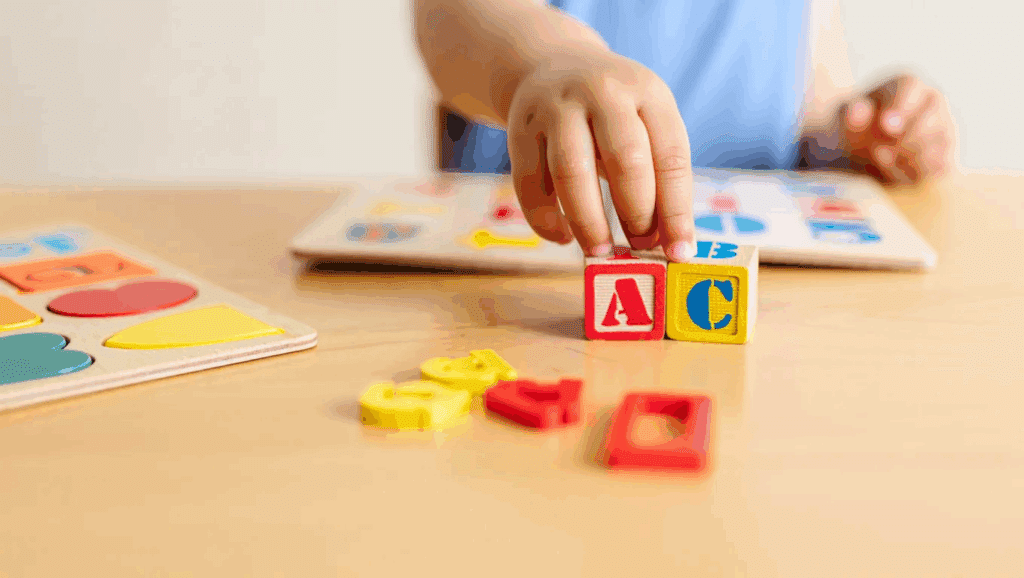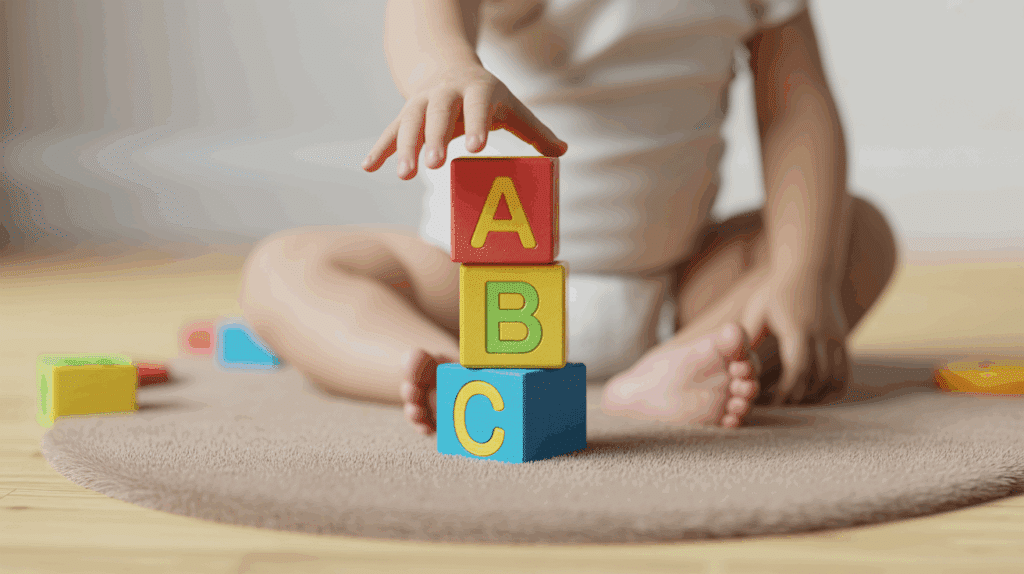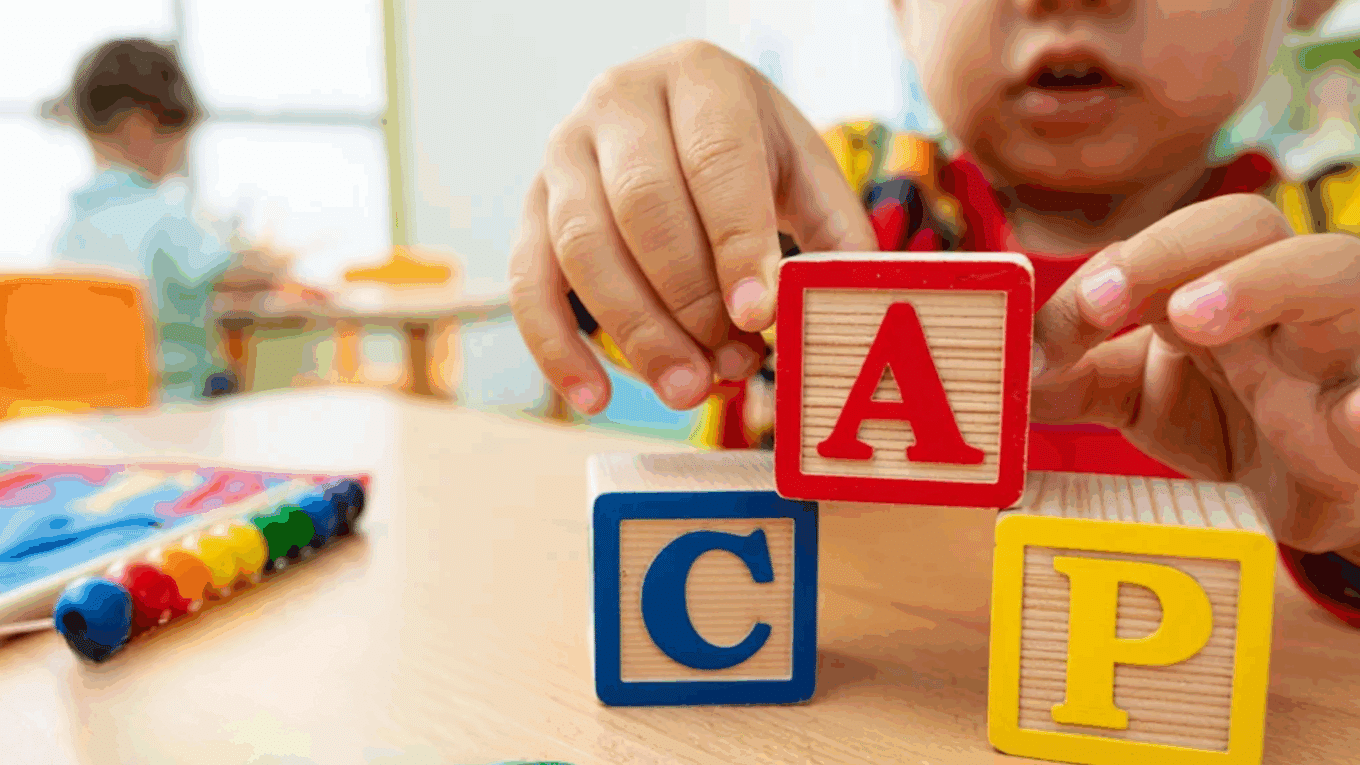Learning the alphabet is a fundamental step in every child’s education odyssey. Parents and teachers often search for effective ways to make this process enjoyable and engaging for little ones.
Letter recognition games offer the perfect solution because they evolve learning into play.
This collection features carefully selected activities that help children identify, remember, and understand letters through interactive play.
From sensory bins to outdoor quests and digital options, these games cater to different learning styles and preferences.
What are Letter Recognition Games?

Letter recognition games are educational activities designed to help children identify and remember letters of the alphabet through playful interaction.
These games make learning feel less like work and more like fun, which increases children’s engagement and retention. They evolve abstract symbols into memorable experiences that build the foundation for reading and writing skills.
Letter recognition games typically feature:
- Visual elements that highlight letter shapes and differences
- Interactive components that engage multiple senses
- Repetition opportunities that reinforce learning
- Reward systems that motivate continued practice
The best letter recognition games adapt to a child’s developmental stage, gradually increasing in complexity as their skills improve.
Benefits of Letter Identification for Preschoolers

When preschoolers engage in letter identification activities, they develop crucial cognitive skills that extend far beyond simply naming the alphabet.
Their young minds form neural connections that serve as building blocks for future academic success.
Letter recognition games provide an enjoyable method for children to absorb these fundamental concepts while their brains are in a critical development period.
- Visual Discrimination Skills: Children learn to notice subtle differences between similar letters like ‘b’ and ‘d’ or ‘p’ and ‘q’. This attention to detail strengthens their ability to distinguish between various visual symbols and patterns in their environment.
- Memory Development: Regularly practicing letter names and sounds strengthens a child’s working and long-term memory. These memory skills transfer to other learning areas as children progress through their educational quest.
- Language Processing: As preschoolers connect letters with their corresponding sounds, they develop phonological awareness. This understanding helps them decode words when they begin reading and improves their overall language comprehension.
- Cognitive Flexibility: Learning that letters can appear in different fonts, sizes, and contexts helps children understand that symbols can remain the same despite changing appearances. This concept builds mental adaptability that supports problem-solving abilities.
- Sequential Thinking: Understanding alphabetical order introduces children to the concept of sequences and patterns. This foundational skill supports later mathematical thinking, logical reasoning, and organizational abilities.
Fun Letter Recognition Games for Early Learners
Helping children recognize letters is one of the first steps in building strong literacy skills. With the right games, kids can find the alphabet while having fun, which keeps them engaged and eager to learn.
These letter recognition activities are designed to spark interest, encourage hands-on play, and reinforce memory.
1. Alphabet Scavenger Hunt
In the Alphabet Scavenger Hunt, letters are hidden around a room or playground, and children are encouraged to find them in order, building letter familiarity in a fun, investigative way.
2. Letter Hopscotch
For Letter Hopscotch, a hopscotch board is created with letters instead of numbers, and children hop to the called-out letter while shouting its name, combining physical activity with alphabet practice.
3. Alphabet Obstacle Course
The Alphabet Obstacle Course involves children navigating a mini obstacle path, collecting specific letter cards, and identifying or saying each letter at checkpoints, enhancing recognition and motor coordination.
4. Musical Letters
This activity is played by arranging letter cards in a circle and having children walk around them to music; when the music stops, they freeze on a letter and shout it out, reinforcing learning through rhythm.
5. Letter Toss Game
In the Letter Toss Game, large letters are placed on the floor, and children toss beanbags onto them, saying the letter and a matching word when they land, blending aiming skills with quick thinking.
6. Balloon Pop ABCs
Balloon Pop ABCs involves inserting paper letters into balloons before inflating them; children pop a balloon, retrieve the letter, and announce it aloud for an energetic and surprising letter reveal.
7. Jump to the Letter
Jump to the Letter has children leap to the correct letter card scattered across the floor after a letter is called, testing listening and recognition skills dynamically.
8. Alphabet Yoga Fun
Alphabet Yoga Fun encourages children to shape their bodies like specific letters using yoga poses, introducing letter shapes in a physical and memorable format.
9. Relay Race with Letters
In Relay Race with Letters, children run to a pile of letters, grab the named one, and race it back to the starting line, building speed, accuracy, and confidence with letter naming.
10. Freeze Dance Alphabet Edition
Freeze Dance Alphabet Edition is played by pausing music randomly and showing a letter card when the music stops; children strike a frozen pose while shouting the letter’s name, practicing recall with laughter.
11. Alphabet Ladder Climb
This game involves taping letters up a staircase or slide and calling them out one at a time; children climb and tap the correct letter, encouraging gross motor activity and memory.
12. Playdough Letter Sculpting
Playdough Letter Sculpting gives children alphabet cards and playdough to mold each letter shape, providing a tactile experience that strengthens muscle memory.
13. Alphabet Painting Time
Alphabet Painting Time lets children paint big, colorful letters with brushes, focusing on a letter of the day to promote creativity and teach letter forms.
14. Sticker Match Alphabet Chart
Sticker Match Alphabet Chart provides a chart with blank spaces and matching stickers for each letter; children find the correct sticker and place it in the right spot for a focused quiet-time activity.
15. Trace the Sandpaper Letters
Letters uses sandpaper cut into letter shapes for children to trace with their fingers, reinforcing recognition through touch and slowing them down to focus.
16. String a Letter Necklace
String a Letter Necklace allows children to string alphabet beads into necklaces in sequence or by spelling names, helping with letter sequencing and fine motor skills.
17. Salt Tray Alphabet Writing
Salt Tray Alphabet Writing fills a tray with salt for children to draw letters using their finger, offering a sensory-rich activity that boosts handwriting readiness.
18. Fridge Magnet Match Game
Fridge Magnet Match Game lets children play with magnetic letters on the fridge and match them to letter flashcards, practicing both uppercase and lowercase recognition.
19. Alphabet Stamp Time
Time provides letter stamps and ink pads for children to stamp out the alphabet or simple words, reinforcing visual recognition and encouraging independent play.
20. DIY Letter Collage Art
This activity has children cut out magazine pictures that start with a specific letter and glue them onto a poster, building phonemic awareness and artistic skills.
21. Foam Letters in the Bath
Foam Letters in the Bath uses floating foam alphabet letters during bath time for children to scoop, match, and name letters as they play, making learning part of their routine.
22. Q-tip Alphabet Art
Q-tip Alphabet Art involves dipping Q-tips in paint and dotting along letter outlines on paper, improving hand-eye coordination and making letter recognition colorful.
23. Alphabet Cookie Decorating
Alphabet Cookie Decorating invites children to bake letter-shaped cookies and decorate them with icing, naming each letter before decorating for a tasty learning experience.
24. Popsicle Stick Letter Building
Popsicle Stick Letter Building has children use colored sticks and a model to form letters, helping them understand letter structure by physically constructing each one.
25. Recycled Cap Matching
This game writes uppercase letters on bottle caps and lowercase on a chart, letting children match and place the caps in the right spots for eco-friendly sorting practice.
26. Alphabet Floor Puzzle Time
Alphabet Floor Puzzle Time gives children a puzzle with letter-shaped pieces to assemble, asking them to name each letter as they work to boost spatial understanding.
27. Letter Bingo Challenge
Letter Bingo Challenge uses bingo boards with letters, calling out random ones for children to mark on their boards, making it great for classrooms and family game nights.
28. ABC App quest
ABC App quest lets children find interactive letter recognition apps with voiceovers, sound effects, and mini games, making tech time productive.
29. Flashlight Letter Hunt
Flashlight Letter Hunt turns off the lights and uses a flashlight to find hidden letter cards around the room, with children calling out each one for a fun twist on hide-and-seek.
30. Dry-Erase Alphabet Maze
Dry-Erase Alphabet Maze designs a maze that requires finding the path by following letter order, with children using markers to trace the route for an educational thinking game.
31. Memory Match with Letters
Memory Match with Letters creates matching pairs of upper and lowercase letters on cards, with children flipping and trying to find matches to train concentration and visual recall.
32. Roll and Rhyme Letter Dice
Roll and Rhyme Letter Dice crafts a large dice with letters on each side, having children roll and name a word that starts with the rolled letter to build vocabulary.
33. Alphabet Wheel Spinner Game
Alphabet Wheel Spinner Game uses a paper spinner labeled with letters, letting children spin and say a word or sentence starting with the result for a simple, reusable learning tool.
34. Match Magnets to Letters
Match Magnets to Letters scatters letter magnets and provides a board with letter outlines, having children match and place them correctly for travel or tabletop play.
35. Alphabet Clothespin Clip Game
Alphabet Clothespin Clip Game writes letters on clothespins and matching ones on a card for children to clip the right letter to the right spot, building hand strength and matching skills.
36. Alphabet Story Chain Fun
Alphabet Story Chain Fun has participants take turns saying a sentence where each one starts with the next letter in the alphabet, creating silly stories and keeping everyone engaged.
37. Find That Letter in Books
This picks a favorite book and goes on a letter hunt within the pages, with children spotting and pointing out specific letters to build reading and recognition skills.
38. Puppet Show with Letter Characters
Puppet Show with Letter Characters makes puppets for each letter using paper bags or socks, with children giving them names and creating mini scenes to enhance verbal skills and creativity.
39. Mystery Sound Letter Game
Mystery Sound Letter Game says a letter sound and asks children to guess the matching letter, strengthening auditory discrimination by mixing similar sounds.
40. Sing the Alphabet with a Twist
Sing the Alphabet with a Twist changes the tempo, volume, or style of the ABC song each time, keeping it fun while reinforcing the order of letters.
41. Alphabet Treasure Map Hunt
Alphabet Treasure Map Hunt draws a pretend treasure map with letter clues along the way, having children follow the map by identifying each letter for an daring learning experience.
42. Letter of the Day Drawing Prompt
This activity picks a letter and asks children to draw three things that begin with it, then discusses their choices to link letters to vocabulary.
43. ABC Flashcard Story Game
ABC Flashcard Story Game lays out flashcards and makes up a story using the letters drawn, promoting storytelling while cementing letter connections.
44. Act Out the Alphabet
Act Out the Alphabet has children choose a letter and act out an animal or object that starts with it, encouraging movement and imagination as others guess what it is.
45. Alphabet Delivery Mail Game
This game creates a pretend mailbox and delivers letter cards to children based on their name or favorite object, with children “receiving” a letter and saying its name for pretend play that teaches.
Conclusion
Letter recognition games offer a powerful blend of education and entertainment that makes the literacy odyssey enjoyable for young learners.
When children engage with letters through play, they develop essential skills without feeling overwhelmed by formal instruction.
The bond created between adults and children during these activities extends beyond academic benefits, fostering communication and shared joy.
By incorporating these games into daily routines, families create an environment where literacy flourishes naturally.




